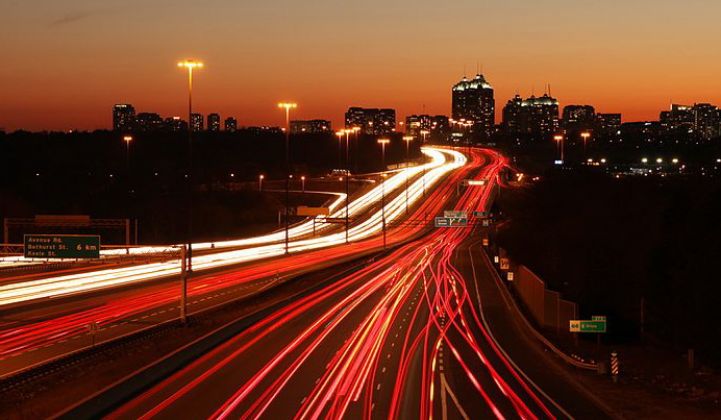Perhaps the idea has occurred to you as you were driving down the road.
There's all this unused land by the side of our nation's highways -- why not install solar there and feed the electrons generated to the grid or power the electrical requirements of the highway, such as street lighting or traffic signals?
The Sacramento Municipal Utility District (SMUD) thought this was a good idea, too. So, armed with ARRA federal funding and the hope of installing solar along Highway 50 in Sacramento, the utility cleared the initial regulatory barriers and put the project out to bid. (SMUD is a publicly owned, non-profit electric utility serving Sacramento County and the sixth-largest muni in the U.S.)
But with those hurdles came increases in price, stemming from factors like road beautification and right-of-way requirements mandated by CalTrans. SMUD received only one bid for the construction, according to Capital Public Radio, and that bid was three times the price per kilowatt-hour SMUD was accustomed to paying.
So the utility scrapped the project and is looking to find out if the grant money might be applied to other projects.
Republic Solar Highways is an organization working to develop commercial PV power generation systems on government-owned properties like highway land. It was this firm that was the sole bidder for the SMUD project.
One look at the 416-page Initial Study/Proposed Mitigated Negative Declaration for the Santa Clara, California Solar Highways roadside project reveals the painful bureaucratic landscape that must be navigated. Right-of-way, landscaping, safety, views, theft, chain-link fencing, setbacks, visual impact on scenic routes, local resident objections, wildlife issues, anti-theft hardware for the PV modules, studies on solar module glare, etc. I could go on. (Here's a link to the 59-megabyte file.)
It seems like an enormous amount of work for the megawatts involved. And the cost of keeping all the stakeholders happy can drive the cost of the project far above the market price of a typical commercial solar installation. We are in an era where we must minimize the "soft costs" of solar -- and this type of project comes with onerous soft costs.
Michael R. Van Every, the Senior Vice President of the Republic Family of Companies, responded to my take on the SMUD project with this: "When you explore the public benefits to the State of California and how state-owned properties can assist in implementation of AB 32, the concept of solar highways is a good one. There are an additional 200 intersections within Caltrans that can be developed in the next 20 years. We recently conducted a benefit-cost analysis for a federal grant, and the Republic Solar Highways Project is a revenue-positive project for the state. The problem with the SMUD project is that it was too small and they picked a very odd-shaped, sloped right-of-way, which contributed to the high costs of construction. Public-private renewable projects are going to cost more, but the public benefits need to evaluated in the long-term, especially if the money generated by these projects can assist in critical public services such as highway maintenance and litter abatement, as well as new jobs and revenue for California.”
It's a difficult time to push through expensive solar projects.
That is not to say that it can't be done. Oregon completed a project of this nature in 2010 and had to go through a series of regulatory gates, including getting the blessing of the Federal Highway Administration (FHWA) in order to complete a system that provides 28 percent of the power for the highway interchange. Panels and inverters came from Oregon's SolarWorld and PV Powered, respectively.
But here's the rub. This was a $1.28 million project for a 104-kilowatt array, according to Rebuilding America's Infrastructure magazine. That's more than $10 per watt -- a ridiculously high price for the taxpayer to pay for solar.
Another project in Oregon broke ground at a rest area with a cost of $10 million for a 1.75-megawatt (DC) project. That looks to be about $5.71 per watt, which is a bit more reasonable.



